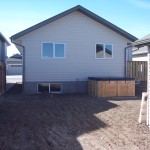Alberta’s southwestern corner is a small area which produces by far the highest amount of precipitation in the province. To see how extreme the precipitation differences are, just take a look at Alberta Transportation’s “Runoff Depth Map” (to the right; Click to enlarge) which governs one of the methods used to determine design flows for […]
Geothermal Heating: Pros, Cons, and Economics
Geothermal energy is produced from heat inside the earth. The temperature at the earth’s core is approximately 5,400 degrees Celsius (9,700 degrees Fahrenheit). From the surface, a few degrees of heat can generally be observed at depths of 20 – 30 m (65 – 100 ft), although this is highly variable. Pros Environmentally friendly Renewable […]
How to Calculate a Water Hammer
Last summer I built an underground sprinkler system for my lawn. As I flipped the switch for the first time and beamed with pride at my wonderful creation, I couldn’t help but notice the loud thud whenever one of the valves closed. Lo and behold (insert joke about engineer building projects here), this is a […]
Fluid Dynamics
Fluid dynamics refers to the study of fluid in motion. It includes fluid moving through pipes, measurements with venturis and orifices, and other motion-related topics such as lift and drag, and pumps. Reference The field of fluid dynamics is a subcategory of fluid mechanics. It’s sibling is fluid statics. In practice, the field of fluid […]
Acceleration Due to Gravity
The normal values for gravitational acceleration used in physics and engineering are: g = 9.8066 m/s2 g = 32.1740 ft/s2 Poles and Equator Because g varies from the poles to the equator, here are the extreme values: North and South Poles: g = 9.832 m/s2 = 32.26 ft/s2. Equator: g = 9.780 m/s2 = 32.09 […]
How to Calculate Relative Density
Relative Density is the ratio of the density of a substance to a specified reference density. $latex D_r = \frac{\rho_s}{\rho_{ref}}&s=2$ Where: Dr = Relative Density (dimensionless) ρs = bulk density of soil (kg/m3 or lb/ft3) ρref = bulk density of reference (kg/m3 or lb/ft3) Often, the reference density is that of water, 62.4 lbs/ft3 or […]
How to Calculate Specific Gravity
Specific Gravity is the ratio of the density of a soil to the density of water. $latex SG = \frac{\rho_s}{\rho_w}&s=2$ Where: SG = Specific Gravity (dimensionless) ρs = bulk density of soil (kg/m3 or lb/ft3) ρw = bulk density of water (kg/m3 or lb/ft3) = 1000 kg/m3 (62.4 lb/ft3) Specific Gravity of Various Substances Substance […]
How to Calculate Bulk Density
Bulk density, also called soil density, is the ratio of the total mass of a soil to the total volume. $latex \rho = \frac{m_t}{V_t}\newline\newline =\frac{m_w + m_s}{V_g + V_w + V_s}&s=2$ Where: ρ = bulk density (kg/m3 or lb/ft3) mt = Total mass (kg or lbs) mw = Mass of water (kg or lbs) ms […]
How to Calculate Degree of Saturation
The degree of saturation is the ratio of the volume of water in a soil to the volume of voids. $latex S = \frac{V_w}{V_v}\times 100\%\newline\newline =\frac{V_w}{V_g + V_w}\times 100\%&s=2$ Where: S = Degree of Saturation Vw = Volume of water (m3 or ft3) Vv = Volume of voids (m3 or ft3) Vg = Volume of […]
How to Calculate Moisture Content
The moisture content of a soil is the ratio of the mass of water in a soil to the mass of solids. $latex n = \frac{m_w}{m_s} \times 100\%&s=2$ Where: mw = Mass of water (kg or lbs) ms = Mass of solids (kg or lbs) The moisture content is thus a ratio which can be […]









